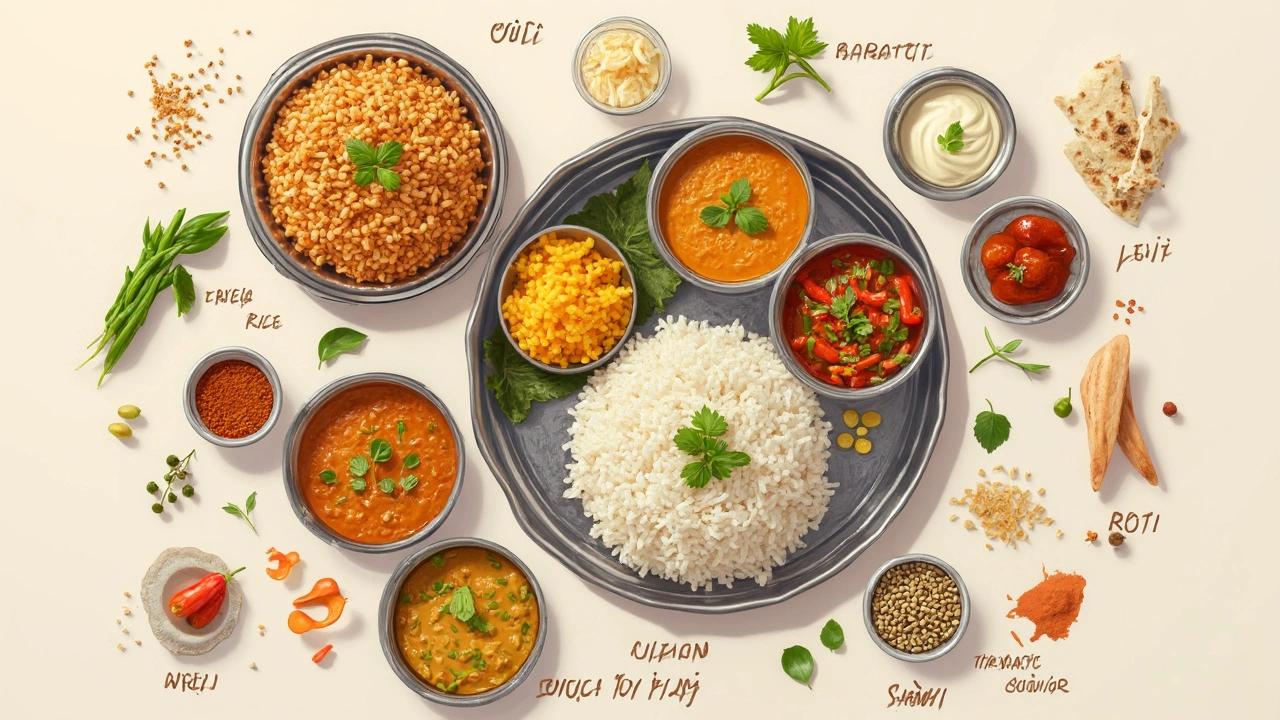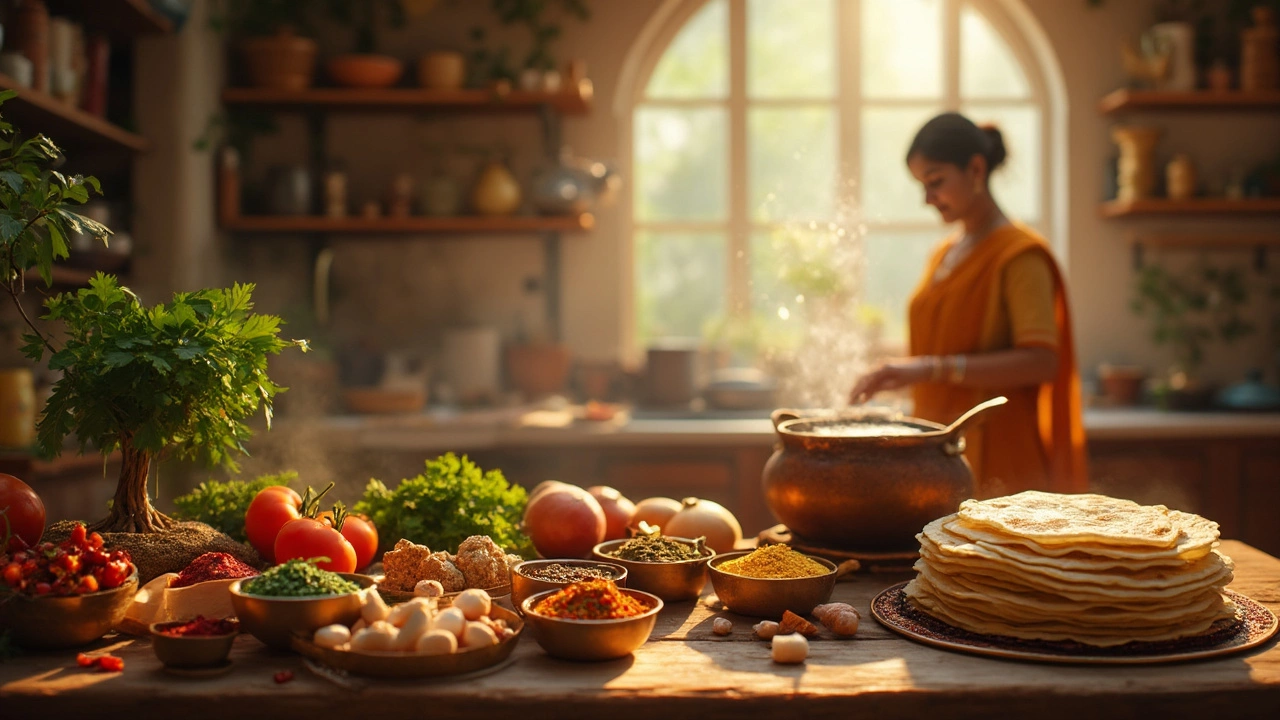Ever wonder why a plate of dal feels like a hug after a long day, or how the smell of tadka (tempered spices) somehow promises everything will be okay? Indian food can look complicated, but the beating heart of Indian kitchens is the simple, basic dish. These dishes aren’t just about saving time or pinching pennies. They’re woven into daily life, across families, from small towns to big cities. Food is comfort. And in India, a basic dish is the ultimate comfort zone, yet each dish comes loaded with culture, history, and plenty of stories to tell.
What Is a Basic Indian Dish? The Ingredients Behind the Magic
Start with the pantry. Any Indian kitchen, no matter how modern or old-school, leans hard on a few trusty staples: rice or roti, lentils (especially split red lentils or moong dal), potatoes, onions, tomatoes, and, of course, a mountain of spices like cumin, turmeric, and red chili powder. Here’s the twist: these ingredients aren’t fancy, but together, they shape the foundation of endless recipes. It’s all about making the most of what’s available.
If you want to understand a basic Indian dish, check the family lunchbox. Nine times out of ten, you’ll see dal chawal (lentils and rice), sabzi roti (spiced vegetable stir-fry with flatbread), or maybe curd rice in the south. “Basic” means filling and nourishing, not boring. Kids and grown-ups both love a bowl of dal because it’s warm, creamy, and always ready to rescue a bland day. There might not be cheese pulls here, but each mouthful is loaded with protein, vitamins, and a satisfying homey vibe.
Let’s talk about basic Indian dish secrets. The real magic comes with the tadka: the sizzling of mustard seeds, cumin, and garlic in hot oil, poured over the dal or sabzi right before serving. This process unlocks crazy flavor in just seconds. Simple, yes. But something about spluttering spices making your kitchen smell like a festival—a trick as old as grandmothers and just as reliable.
Here’s a quick peek into what you’ll find in a basic Indian pantry for daily meals:
- Lentils: moong, masoor, toor (split pigeon peas)
- Basmati or regular rice
- Whole wheat flour for flatbreads
- Common vegetables: potatoes, onions, tomatoes, eggplant, okra, spinach
- Essential spices: turmeric, cumin, coriander, red chili powder, mustard seeds
- Ghee or vegetable oil
Don’t let the number of ingredients spook you. Most dishes stick to ten or fewer basics you’ll find in any Indian store. And let’s not ignore how many of these recipes can be vegetarian or vegan without a second thought—not for trends, but because that’s how home cooking happens.
Popular Classic Dishes: Down-to-Earth But Packed With Flavor
Indians love their feasts, but for the day-to-day, they’re fiercely loyal to a handful of simple dishes. Dal, for example, is so much a part of Indian daily life that there’s a saying: “Dal-roti ghar ki, maas (meat) hotel ka,” meaning “Dal and roti are homely, but meat is for restaurants.” It doesn’t matter where in India you travel, dal has a spot on every dining table.
Take dal tadka—lentils simmered until soft, then crowned with a sizzling mix of cumin, garlic, and chilies fried in hot oil. It’s healthy, cheap, and tastes way richer than it looks. There’s dal fry, which uses yellow lentils and a tomato-onion base. Then there’s rajma (red kidney bean curry) and chana masala (spicy chickpeas), both cooked in spicy, tomato-heavy gravies. Pair these with rice or roti, and you’ve got a meal that’s easy, filling, and loaded with flavor.
Don’t forget about sabzi—any spiced vegetable dish counts. This could be aloo gobi (potatoes and cauliflower), bhindi masala (okra stir fry), or baingan bharta (mashed smoky eggplant). The techniques are almost always the same: chop, sauté onions and garlic, add spices, toss veggies, cook until done. That’s basically the blueprint for countless “basic” dishes from Kashmir to Kerala.
Here’s a quick comparison of a few go-to everyday dishes, if you’re ever staring at a menu and feeling lost:
| Dish | Main Ingredient | Common Pairing | Prep Time (mins) |
|---|---|---|---|
| Dal Tadka | Lentils | Rice/roti | 40 |
| Chana Masala | Chickpeas | Roti/bhatura | 50 |
| Aloo Gobi | Potato, Cauliflower | Roti | 35 |
| Bhindi Masala | Okra | Rice/roti | 30 |
| Curd Rice | Rice, Yogurt | Papadum | 20 |
No matter where you go, these humble dishes grab centerstage at family dinners and lunchboxes. It’s the kind of food that gets requested easily after a vacation, simply because nothing else tastes so familiar, so right.

Why Do Indians Love Simple Food? It’s All About Comfort and Connection
So, why does the “basic” matter so much? It’s about more than eating healthy or saving time. There’s cultural comfort in a plate of dal chawal or a bite of hot roti with lightly spiced aloo sabzi. These dishes carry family traditions—recipes that get passed down like a secret handshake between generations.
In a lot of Indian homes, the act of making these dishes is almost meditative. There’s a rhythm to chopping, frying, and simmering. Making rotis by hand—rolling each ball of dough, pressing them just so, and puffing them over a flame—can be oddly soothing. It’s about slowing down in a fast world, finding happiness in familiar flavors.
Basic Indian food is also super adaptable. Got just potatoes and an onion? You can make aloo ki sabzi. A handful of lentils and the most basic spices? There’s your dal. These dishes are designed to fit around what’s seasonal or affordable, so families never feel left out or stretched too thin. It’s smart cooking—make do with what you’ve got and still end up with something delicious.
And here’s something cool: a study by the Indian Council of Medical Research (2023) found that the simple Indian combination of lentils, rice, and stir-fried veggies delivers all nine essential amino acids and plenty of fiber—meeting daily nutrition recommendations for most families, even when on a tight budget. These dishes aren’t just tasty; they’re unconsciously balanced for health.
Plus, these meals are easy to customize. You want more protein? Add paneer or eggs to your sabzi. Want to make it vegan? Just use oil instead of ghee and skip dairy. There’s no ‘one size fits all’ approach—just your food, your way.
Tips, Tricks, and FAQs: How to Master a Basic Indian Dish at Home
If you’re itching to try this at home but feel lost, relax. Getting the basics down is way easier than it seems. Here are shortcuts and smart ideas straight from Indian home kitchens that make daily cooking stress-free but full of flavor.
- Use a pressure cooker: Lentils, beans, and even some veggies cook so much faster. Most Indian homes wouldn’t survive without one. Invest in a good pressure cooker and you’ll get that perfect dal texture in half the time.
- Fresh spices matter: If you’ve got old turmeric or cumin hiding at the back of your cupboard, swap it for fresh stock. The right fragrance makes a world of difference. Toast your whole spices in hot oil—never skip this step for dal or sabzi.
- Balance the flavors: Classic Indian recipes always combine salty, spicy, slightly tangy, and sometimes a hint of sweet. A spoon of lemon juice or a pinch of sugar at the end can lift even a basic dish into something special.
- Don’t drown in oil: You can make these dishes lighter. Just use a tablespoon of oil and a nonstick pan if you’re watching calories. Nutrition doesn’t have to take a backseat.
- Prep ahead: Chop onions, tomatoes, garlic, and ginger in advance—store in freezer cubes and cooking is suddenly three times faster.
- Go seasonal: Stick with veggies in season. They’re cheaper and actually taste better. Spinach, pumpkin, or ridge gourd in spring, potatoes and cauliflower in winter—the market will tell you what to use.
FAQs:
- What’s the easiest Indian dish I can make as a beginner? Dal tadka is your best bet. One pot, easy caramelized onions, tomatoes, and cumin, and you’re set.
- Does every meal need rice and roti? Not at all. In the south, rice is the winner. Up north, roti is favorite. But loads of people mix it up, depending on mood and what’s available.
- What if I don’t have Indian spices? Start with cumin and turmeric—almost any basic dish can be made with just these two. Gradually expand as you get confident.
- How can I make these dishes healthier? Use less oil, add more veggies, and spice up with lots of herbs like cilantro and mint.
So, next time you crave Indian food, don’t stress about fancy curries or dozens of ingredients. The soul of Indian kitchens, from Gujarat to Kolkata, is in the basic, everyday dish. These are the recipes that keep homes happy, full, and always ready to share another story around the dinner table.
